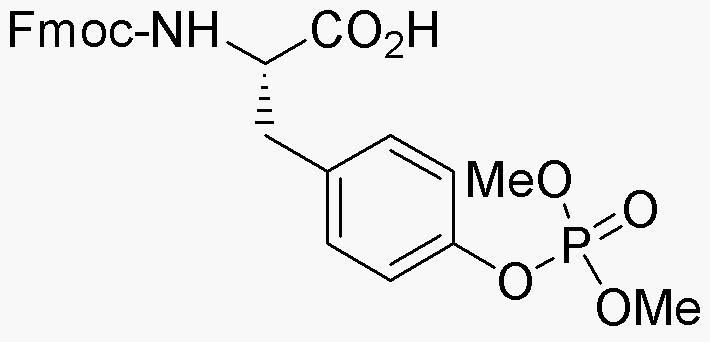Fmoc-O-dimethylphospho-L-tyrosine is widely utilized in research focused on:
- Peptide Synthesis: This compound serves as a crucial building block in the synthesis of phosphotyrosine-containing peptides, which are important for studying protein interactions and signaling pathways.
- Drug Development: It is used in the development of pharmaceuticals targeting tyrosine kinases, which play a significant role in cancer and other diseases, providing a pathway for innovative treatments.
- Bioconjugation: The chemical is employed in bioconjugation techniques, allowing researchers to attach biomolecules to surfaces or other molecules, enhancing the effectiveness of drug delivery systems.
- Analytical Chemistry: It aids in the development of analytical methods for detecting and quantifying phosphotyrosine in biological samples, facilitating research in cellular signaling and disease mechanisms.
- Biotechnology: This compound is utilized in various biotechnological applications, such as the design of biosensors that can detect specific proteins or enzymes, improving diagnostic capabilities.
Información general
Propiedades
Seguridad y normativas
Aplicaciones
Fmoc-O-dimethylphospho-L-tyrosine is widely utilized in research focused on:
- Peptide Synthesis: This compound serves as a crucial building block in the synthesis of phosphotyrosine-containing peptides, which are important for studying protein interactions and signaling pathways.
- Drug Development: It is used in the development of pharmaceuticals targeting tyrosine kinases, which play a significant role in cancer and other diseases, providing a pathway for innovative treatments.
- Bioconjugation: The chemical is employed in bioconjugation techniques, allowing researchers to attach biomolecules to surfaces or other molecules, enhancing the effectiveness of drug delivery systems.
- Analytical Chemistry: It aids in the development of analytical methods for detecting and quantifying phosphotyrosine in biological samples, facilitating research in cellular signaling and disease mechanisms.
- Biotechnology: This compound is utilized in various biotechnological applications, such as the design of biosensors that can detect specific proteins or enzymes, improving diagnostic capabilities.
Documentos
Hojas de datos de seguridad (HDS)
La SDS proporciona información de seguridad completa sobre la manipulación, el almacenamiento y la eliminación del producto.
Especificación del producto (PS)
La PS proporciona un desglose completo de las propiedades del producto, incluida la composición química, el estado físico, la pureza y los requisitos de almacenamiento. También detalla los rangos de calidad aceptables y las aplicaciones previstas del producto.
Certificados de análisis (COA)
Busque certificados de análisis (COA) ingresando el número de lote del producto. Los números de lote y de partida se pueden encontrar en la etiqueta de un producto después de las palabras "Lote" o "Lote".
Número de catálogo
Número de lote/lote
Certificados de origen (COO)
Este certificado de origen confirma el país en el que se fabricó el producto y también detalla los materiales y componentes utilizados en él y si se deriva de fuentes naturales, sintéticas u otras fuentes específicas. Este certificado puede ser necesario para cumplir con las normativas aduaneras, comerciales y regulatorias.
Número de catálogo
Número de lote/lote
Hojas de datos de seguridad (HDS)
La SDS proporciona información de seguridad completa sobre la manipulación, el almacenamiento y la eliminación del producto.
DownloadEspecificación del producto (PS)
La PS proporciona un desglose completo de las propiedades del producto, incluida la composición química, el estado físico, la pureza y los requisitos de almacenamiento. También detalla los rangos de calidad aceptables y las aplicaciones previstas del producto.
DownloadCertificados de análisis (COA)
Busque certificados de análisis (COA) ingresando el número de lote del producto. Los números de lote y de partida se pueden encontrar en la etiqueta de un producto después de las palabras "Lote" o "Lote".
Número de catálogo
Número de lote/lote
Certificados de origen (COO)
Este certificado de origen confirma el país en el que se fabricó el producto y también detalla los materiales y componentes utilizados en él y si se deriva de fuentes naturales, sintéticas u otras fuentes específicas. Este certificado puede ser necesario para cumplir con las normativas aduaneras, comerciales y regulatorias.


